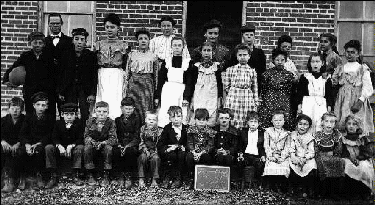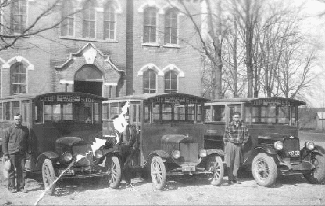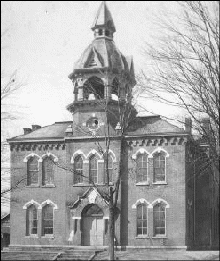
Note: The following article is a summary of a research
project written by Mary Ellen (Miller) Boller who retired from the Sidney City Schools in
1993. Photos are also courtesy of Mary.
The importance of schooling in our community was established from the beginning by
Charles Starrett, the founder of Sidney.
Starrett set forth several stipulations for his gift of land for the town, one of which
was "one acre for the use of the schools."
As settlers arrived, the need for schools became evident. At first, churches met the
needs of the community. Cephas Carey brought the first teacher here for his children and soon other families were hiring
teachers for their children.
The first free school was established in the county in 1841. Most were subscription
schools, where the student paid to attend. School then usually lasted four months as
students were expected to work on the farm the rest of the year. By the late 1800s, a few
communities in Shelby County had high schools, but most had no more than eight grades.
The requirement for teaching, especially in the one room schools, was usually just
passing a teacher’s examination. No college degree was required. Emphasis was placed
on reading, writing, arithmetic and spelling.
In 1856, the citizens of Sidney approved a tax levy of $12,000 to build a school. After
much heated debate, the site selected was the one set aside by Starrett for a school. It
was a brick three-story building, with 12 classrooms. This first school was called the
Union School and was located on the site of the current Central Elementary School today.
A ward school was built in each of the four city wards before 1900, with each
school taking the name of the ward.
Below, bus drivers wait to transport Port
Jefferson students home. Photo courtesy of Mary Boller.

For many years, black residents were educated at the ‘colored school', located where the
National Guard Armory was later situated (now home to the Cameo
Theatre). In 1887, this school was discontinued when the city schools opened to both black
and white students. The Catholic Church also started a school for Catholic students,
beginning with a partitioned area of the church in 1858. A school building was erected on
the church grounds in 1876.
Because of the influx of people and the growth of industry, the schools in Sidney needed to
grow also. In 1903, the third floor of the Union School was condemned. A rally was held in
downtown Sidney and a committee was formed to plan a new high school and junior high
school. By 1909, a proposal was made to secure the no-longer-used Presbyterian
Cemetery for part of the school grounds. This was one of the cemeteries set aside in the
original Starrett land. Work was begun on relocating the graves to the new cemetery at the
south end of town.
A donation by Miss Julia Lamb allowed the school to purchase a large area of land near
the Miami River, which became the high school football field. The first class graduated
from the new high school in 1914. The junior high building was not added until later. This
building was later called Bridgeview Middle School. That building was torn down when the new Sidney Middle School opened in 2004. Less well known is the fact
that Sidney had a college in the early 1900s, known as the Buckeye Business College. The
classes of 1904 and 1905 graduated together in 1906, then it closed.
During the 1920s,
voters approved a tax levy for construction of Central School, Parkwood School and the
addition of a junior high school to the existing high school. Parkwood came about with the
annexation of a community called Jimtown to the north of Sidney. It was built to accommodate students living in the northern part
of the town and Central School was built to replace the old building on the site.
During the 1930s, Port Jefferson became a part of
the Sidney school system, and later Maplewood also joined. Orange Township then became
part of the system and the bussing of students to school became a familiar sight by the
late 1930s.
After World War II, the citizens of Sidney encountered the
need for more schools as a result of the ‘baby boom.’ This resulted in the
renovation of the Port Jefferson and Maplewood schools, replacement of the old ward
schools with four new buildings. Whittier, Emerson, Longfellow and finally Lowell schools
opened their doors in the early 1950s.
Parkwood Junior High School (now Northwood) was
built and the junior high programs eventually divided between Northwood and what became
Bridgeview. Finally, in 1960, the new Sidney High School on Campbell opened its doors. In
1969, after an addition was made, Sidney High School included 9th through 12th grade
students.
Throughout the history of the educational system,
the community has responded to maintain a high quality of education. A joint effort
between education and business has also been instrumental in maintaining the quality
educational system.

The last students
attended Port Jefferson School (pictured above) in 1979-80. It was later torn down.
[ Back to Education Index ] |

